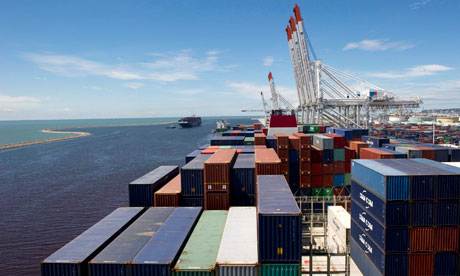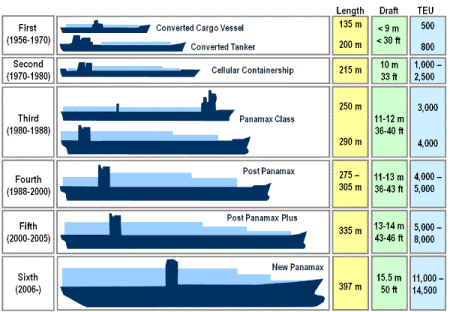 According to the Guardian,
According to the Guardian, the world’s largest cargo ships are travelling at lower speeds today than sailing clippers such as the Cutty Sark did more than 130 years ago.
A combination of the recession and growing awareness in the shipping industry about climate change emissions encouraged many ship owners to adopt “slow steaming” to save fuel two years ago. This lowered speeds from the standard 25 knots to 20 knots, but many major companies have now taken this a stage further by adopting “super-slow steaming” at speeds of 12 knots (about 14mph).
Travel times between the US and China, or between Australia and Europe, are now comparable to those of the great age of sail in the 19th century. American clippers reached 14 to 17 knots in the 1850s, with the fastest recording speeds of 22 knots or more.
Maersk, the world's largest shipping line, with more than 600 ships, has adapted its giant marine diesel engines to travel at super-slow speeds without suffering damage. This reduces fuel consumption and greenhouse gas emissions by 30%. It is believed that the company has saved more than £65m on fuel since it began its go-slow.
Ship engines are traditionally profligate and polluting. Designed to run at high speeds, they burn the cheapest "bunker" oil and are not subject to the same air quality rules as cars. In the boom before 2007, the Emma Maersk, one of the world's largest container ships, would burn around 300 tonnes of fuel a day, emitting as much as 1,000 tonnes of CO2 a day – roughly as much as the 30 lowest emitting countries in the world.
Maersk spokesman Bo Cerup-Simonsen said: "The cost benefits are clear. When speed is reduced by 20%, fuel consumption is reduced by 40% per nautical mile. Slow steaming is here to stay. Its introduction has been the most important factor in reducing our CO2 emissions in recent years, and we have not yet realised the full potential. Our goal is to reducing CO2 emissions by 25%."
The article pitches slow steaming as financially beneficial for the shipping companies, environmentally beneficial for the world and "here to stay." I'm not so sure ....
To put the change into context, globalization was the dominant economic trend of the last 40 years. Manufacturing of many types shifted from North America and Europe to various low cost producers in the developing world, but the bulk of that manufacturing was still consumed in Europe and North America.
 Containerized shipping emerged as a cost effective way to facilitate the massive growth in transportation of goods that accompanied this economic shift. Wal-Mart, Costco and other stores used high technology to manage inventory and drive down the cost of transportation and storage in order to sell at the lowest possible price. The emergence of big box retail is the flip side of outsourced manufacturing. Driven by the the need for expanded transportation capacity and the retailer's emphasis on just-in-time delivery the shipping industry responded by building larger and faster ships, container rail, etc.
Containerized shipping emerged as a cost effective way to facilitate the massive growth in transportation of goods that accompanied this economic shift. Wal-Mart, Costco and other stores used high technology to manage inventory and drive down the cost of transportation and storage in order to sell at the lowest possible price. The emergence of big box retail is the flip side of outsourced manufacturing. Driven by the the need for expanded transportation capacity and the retailer's emphasis on just-in-time delivery the shipping industry responded by building larger and faster ships, container rail, etc.  Container ships, as shown, have increased in size and capacity. (Capacity is meausred in Twenty-foot Equivalent Units (TEU), that is the number of twenty-foot containers the ship can carry.) PanaMax class ships (ships limited in size by their ability to pass through the Panama Canal), which dominated shipping during the 80's, have been surpassed by the larger Post-PanaMax classes. When the current expansion of the Panama Canal is complete, sixth generation ships from the New PanaMax class will be able to navigate the canal.
Container ships, as shown, have increased in size and capacity. (Capacity is meausred in Twenty-foot Equivalent Units (TEU), that is the number of twenty-foot containers the ship can carry.) PanaMax class ships (ships limited in size by their ability to pass through the Panama Canal), which dominated shipping during the 80's, have been surpassed by the larger Post-PanaMax classes. When the current expansion of the Panama Canal is complete, sixth generation ships from the New PanaMax class will be able to navigate the canal. But ships have not only increased in size (blue line), but also in speed (green line) and carrying capacity (bottom axis). However, while it is possible to get larger ships to meet the speed of earlier ships by increasing the size of the motor (red line), current designs have reached the limits of speed. It is from these maximum designed limits that current shipping speeds have been reduced.
But ships have not only increased in size (blue line), but also in speed (green line) and carrying capacity (bottom axis). However, while it is possible to get larger ships to meet the speed of earlier ships by increasing the size of the motor (red line), current designs have reached the limits of speed. It is from these maximum designed limits that current shipping speeds have been reduced.But the question of whether or not the slow speeds are here to stay hinges on the future of globalization and the nature of the transportation/distribution system that has evolved with it. Stated in resilience theory terms, will the world economy rebound and return to its previous system state? If that is the case, then we would expect slow speeds to be a temporary phenomena. Or, is the current economic slump the leading edge of a global economic transition that de-emphasizes globalization and re-emphasizes localization? If that is the case, then the slow speeds may be here to stay.
 I don't claim to know enough to answer the question, but some additional understanding of the economic context is important. Following the banking collapse of 2008 the global economy went into recession and factories slowed production. Without the need for so much capacity, the shipping industry removed a significant number of ships from use and instituted the slow shipping provisions. As the economy has recovered (at least somewhat) the increased demand for shipping has not been met by adding additional ships (i.e., expanded capacity) and, as shown in the chart, the cost of shipping has increased significantly.
I don't claim to know enough to answer the question, but some additional understanding of the economic context is important. Following the banking collapse of 2008 the global economy went into recession and factories slowed production. Without the need for so much capacity, the shipping industry removed a significant number of ships from use and instituted the slow shipping provisions. As the economy has recovered (at least somewhat) the increased demand for shipping has not been met by adding additional ships (i.e., expanded capacity) and, as shown in the chart, the cost of shipping has increased significantly. From what I've been able to tell, the retail end of things has been able to factor in both the additional cost of transportation and information that a particular product is no longer in production/available. What they seem to be up in arms about is the distribution issue -- the product is in production but delayed. Google 'shipping delays' and you will see what I mean. Globalized retailers have built just-in-time delivery into their retail scheme. And not having a product on the shelf is a no no. Telling a customer it will be in by day X and not have it show is even worse. Simply put, whether or not slow shipping stays will be dependent on changes in the retail industry. If the big box model collapses and/or other industries (like consumer electronics) that dependent on just-in-time delivery can adapt to slower delivery times, then slow shipping will remain. If, however, the global economic system turns out to be resilient and things return to the way they were, I suspect the pressure for speeded up delivery will be too great for the shipping industry to ignore.
No comments:
Post a Comment